Menu Anywhere¶
Overview¶
The AgileData App simplifies the process of collecting, profiling and managing data for data analysts and consultants. As part of this mission, the interface of the app contains an advanced menuing system saving you a lot of time and effort when navigating from one screen to another.
We call this “Menu Anyhwere” and it is designed to allow you to go between any screen with a single click, and to retain the context you had applied in the previous screen. No more having to open a new screen and searching for the thing you were just looking at to see the related information about it.
The Data Map overview provides a complete lineage of all collected and stored in History Tiles, which Concept, Detail and Event Tiles they’re related to and into which Consume Tiles the data is finally published to. Each tile is represented as a circle and by clicking on any of the circles you can go immediately to view that tiles details or access the rules associated with that tile.
It is possible to directly switch from a tile in the catalog to the tile detail screen and from there to the rule detail screen showing the rules that are applied to the data in the tile. Simultaneously, you can switch back from the rule detail screen to the tile detail screen of the associated tile with a single click.
Both from the tile detail screen and the rule detail screen you can access the CustomSync feature, quickly accessing ADI to take the desired action. You also can go to the CustomSync feature from any tile in the catalog.
All in all the Menu Anywhere capability of the AgileData App enables you to switch easily between different views of the data from anywhere within the app, simplifying your work and letting you find what you’re looking for in no time.
The Menu Anywhere is available throughout the AgileData App. just look for the … menu option.
For this guide we will use a couple of examples to show how Menu Anywhere works.
Steps¶
1. Check the Data Map screen to get an overview of the tiles¶
If you’re working with a lot of data and files it can be advantageous to gain a high-level overview of what data is actually saved in your AgileData Tenancy. The Data Map screen provides you with an easy way to get an overview of which tiles are in the catalog and how they are related to each other via different types of rules.
You can access the Data Map by clicking on the “Rules” menu and selecting the “Data Map” option.
The Data Map represents each tile in the catalog as a circle. The lines between the circles represent the rules that were run to populate the tiles with data.
The circles on the left side correspond with History Tiles in the Catalog. These were populated directly with the data that has been collected. The circles in the middle correspond with Concept, Detail or Event Tiles in the Catalog which were populated with data from a History Tile. The circles on the right side represent Consume or Info App Tiles with data which is ready to be used in data visualisations, reports and dashboards.
By clicking on any of the circles you can open the detail menu. Choose “View Lineage” to see which tiles are connected to the currently selected tile.
For example, the History Tile with data about Telecom Customer Churn is related via a Detail Rule marked in orange with a Detail Tile and it is also related via a Concept Rules higlighted in blue with a Concept Tile. Both the Detail Tile and the Concept Tile are connected to a Consume Tile highlighted in purple. This is how you can gain a visual overview of how your data has been processed in the AgileData Platform.
1. Switch to the tile detail screen from the Data Map¶
You can directly access the tile detail screen from the circles representing the tiles in the Data Map. Click on any circle to select a tile and then click on “View Tile” to switch to the corresponding tile detail screen of the selected tile.
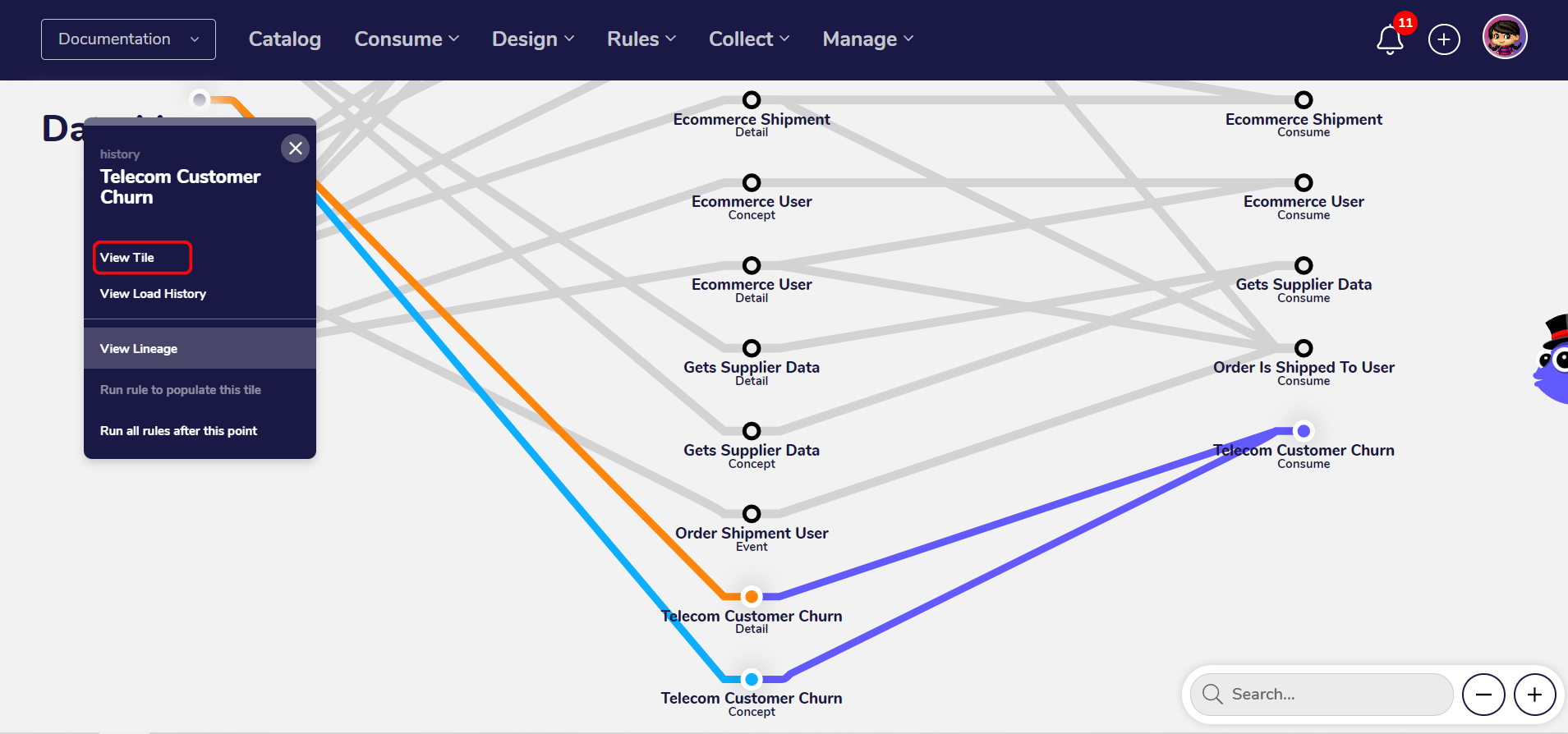
The tile detail screen provides you with an overview of detailed information about the data within the tile including a data preview, a summary of associated trust rules, any context or votes which were added by users and some summary statistics like the row and column count.
3. Switch to the rule detail screen from the tile detail screen¶
From the tile detail screen, you can also directly view the rules that are associated with that tile by switching to the rule detail screen. You can do so by clicking on the three dots in the top right corner and selecting “View Change Rules”.
The rule detail screen shows which rules were used to populate the tile with data and how these rules were created.
It is furthermore possible to directly switch back from the rule detail screen to the tile detail screen of the associated tile by clicking on the three dots in the top right corner and selecting “View Tile”.
Being able to immediately go from the tile to its rule detail screen greatly simplifies the process of looking up the rules that are connected to a tile. Without this feature, you would have to go to the general list of rules under the “Rules” menu and browse through the entire list until you find the connected rule. This is just one way how Menu Anywhere in the AgileData App is helping you to save time while working with your data.
4. Access the tile detail and the rule detail screen from the Catalog¶
The tile detail screen and the rule detail screen also can be directly accessed from the tiles in the Catalog.
To go to the tile detail screen of a tile, click on the tile and you are taken immediately to the detailed view.
Alternatively, click on the three dots in the top right corner of the tile and select “View Tile”.
To go to the rule detail screen of a tile, click on the three dots in the top right corner of the tile and select “View Change Rule”.
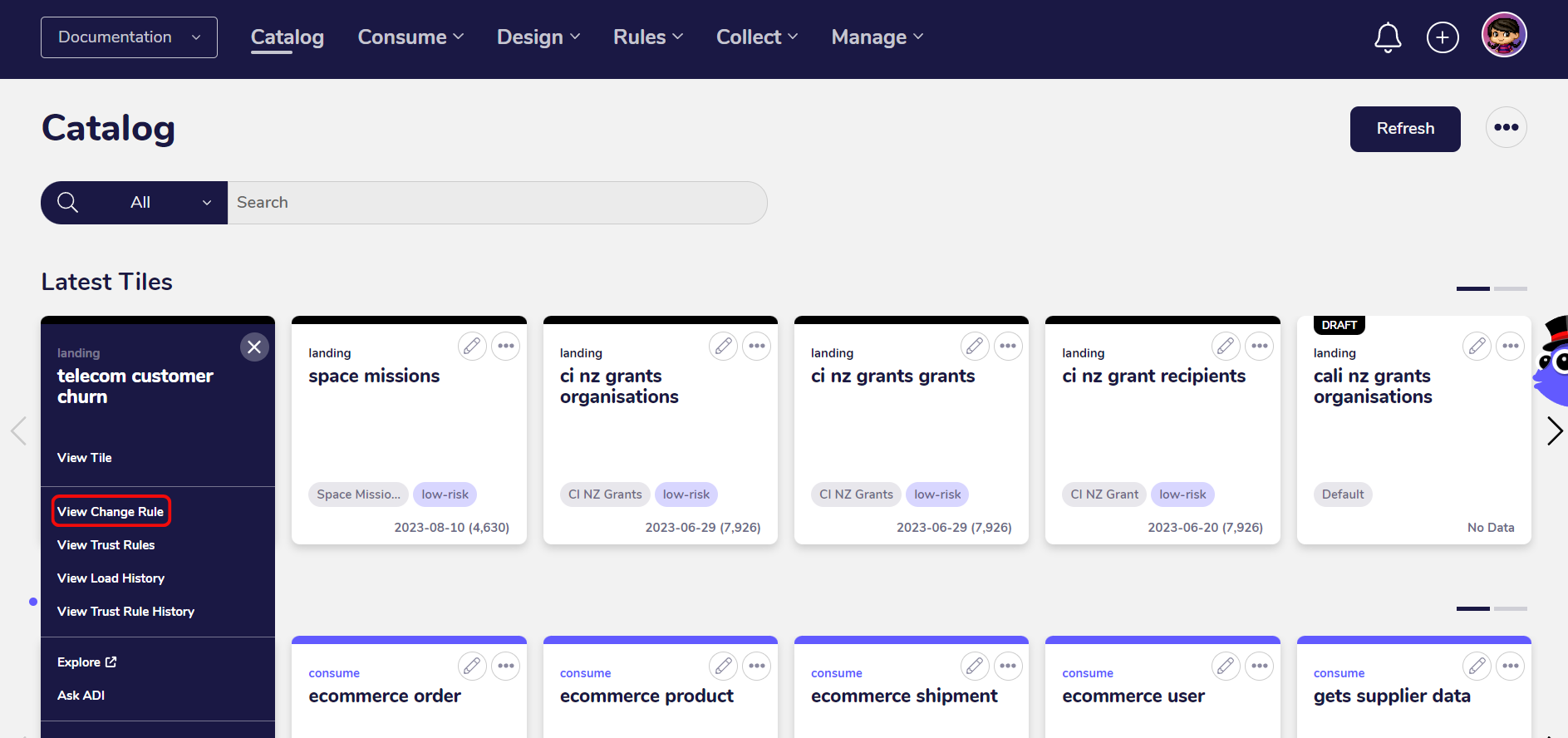
This makes it easy to access detailed information about the tiles from the overview in the Catalog.
5. Access the CustomSync feature from anywhere¶
Through Menu Anywhere, you can also access the CustomSync feature of the AgileData App. Regardless of whether you are in the Catalog, in the tile detail screen or in the rule detail screen, you can open a dialogue in ADI to start a CustomSync action with a single click.
If you’re in the Catalog, click on the three dots in the top right corner of a tile and select “CustomSync” from the detail menu.
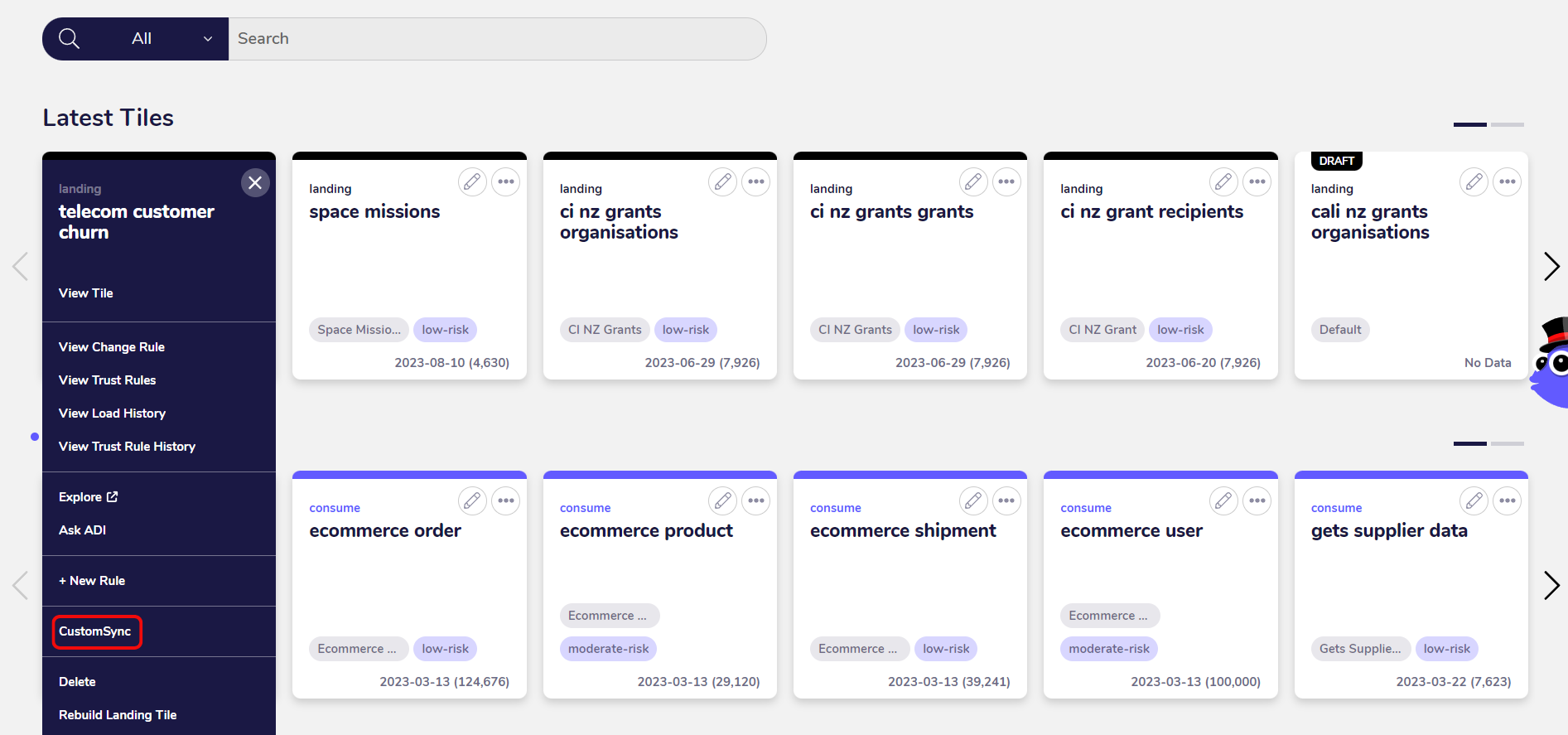
If you’re in the tile detail screen, click on the three dots in the top right corner and select “CustomSync”.
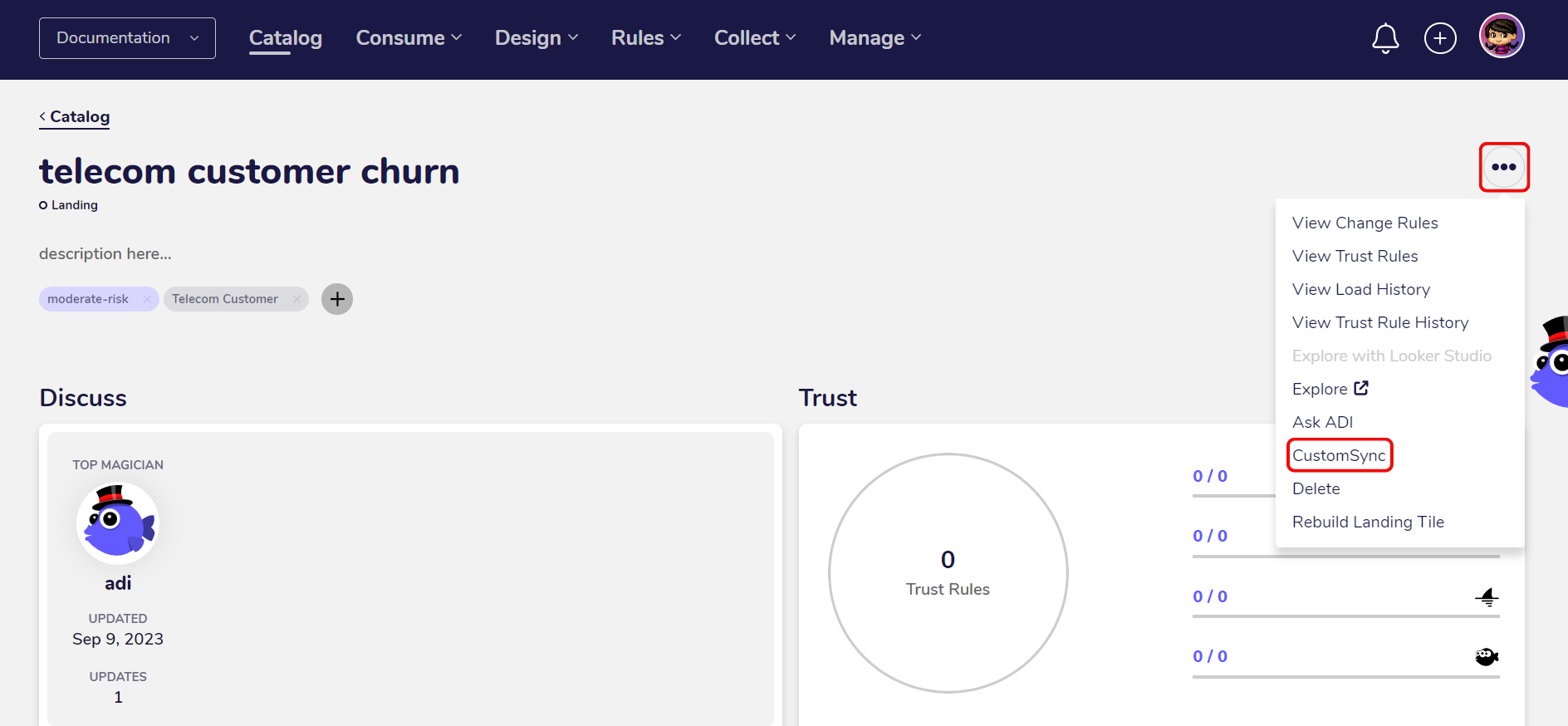
If you’re in the rule detail screen, click on the three dots in the top right corner and also select “CustomSync”.
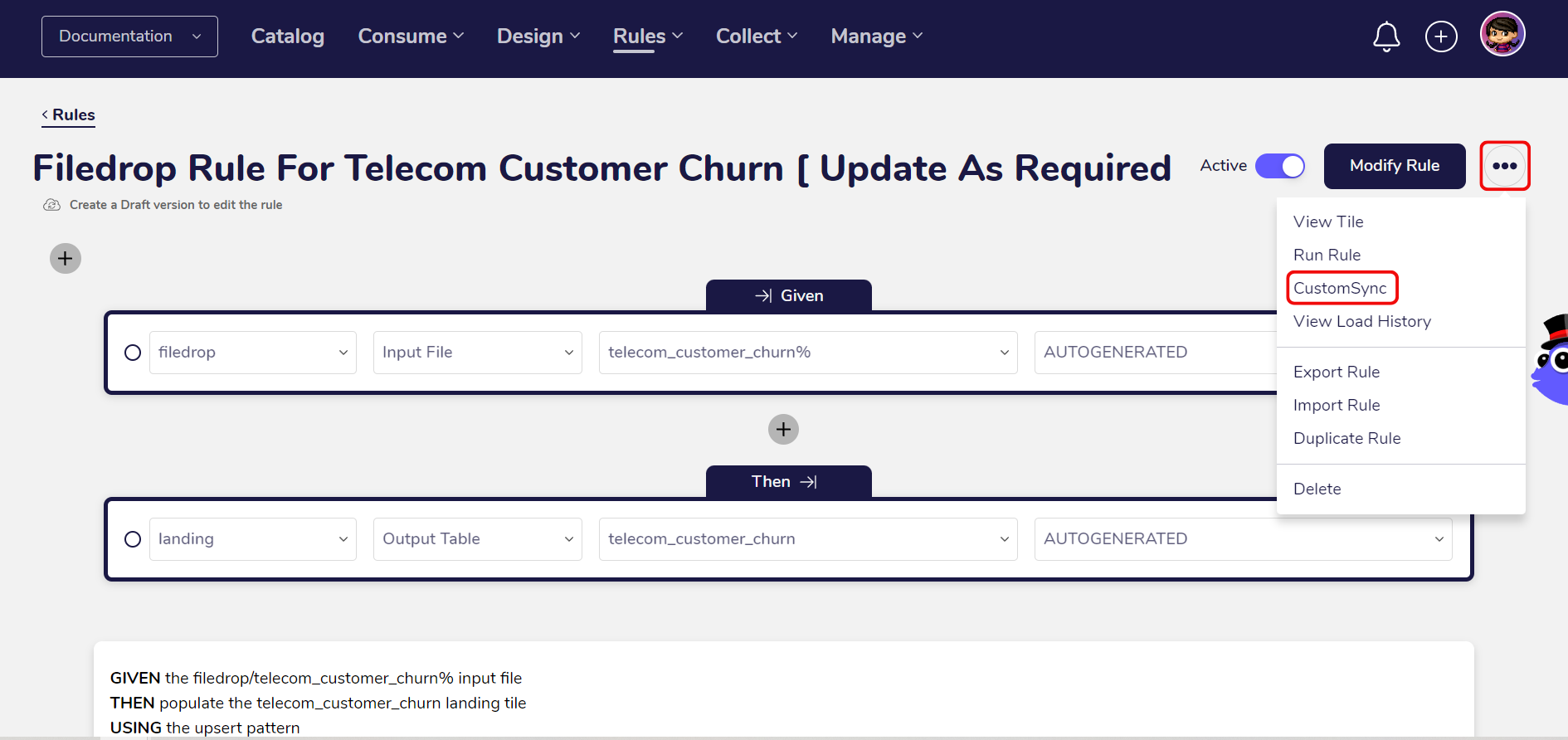
The dialogue in ADI will guide you through further steps to take the desired action.
Use Cases¶
1. Understand how the tiles in the Catalog are connected¶
Menu Anywhere in the Data Map overview and the Catalog overview is very useful if you want to understand how the different tiles in your AgileData Tenancy are connected. For example, data from a History Tile usually is used to populate a Consume Tile via a Concept Rule and a Detail Rule.
In the Data Map overview, you can not only view these connections in a single diagram but also directly access detailed information about the tiles and rules by switching to the detail screens.
This makes it a matter of minutes to gain an understanding of the data from your uploaded files and how it was structured in the AgileData App, enabling you to work more efficiently when using it during data reporting and data exploration.
2. Find the rules associated with a tile¶
Menu Anywhere also gives you a quick and easy way to find the rules associated with a tile. When working with the data in your AgileData Tenancy you should understand what rules were used to populate the tiles so that you can control how your data is transformed and processed.
Browsing through the rules list under the “Rules” menu can be tedious and time-consuming. By being able to directly switch from any tile to its associated rules you can skip this step and don’t have to waste any time searching for the rule you’re looking for.
As such, working with your data becomes a fast and efficient process in the AgileData App, supporting our vision of giving data analysts and consultants a fast and easy solution to handle their data in a structured way.
